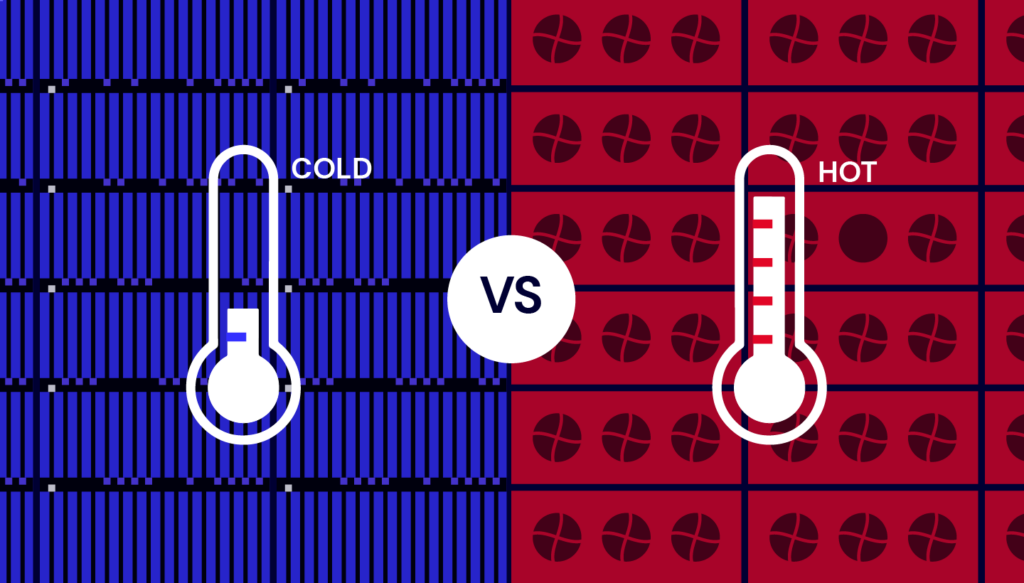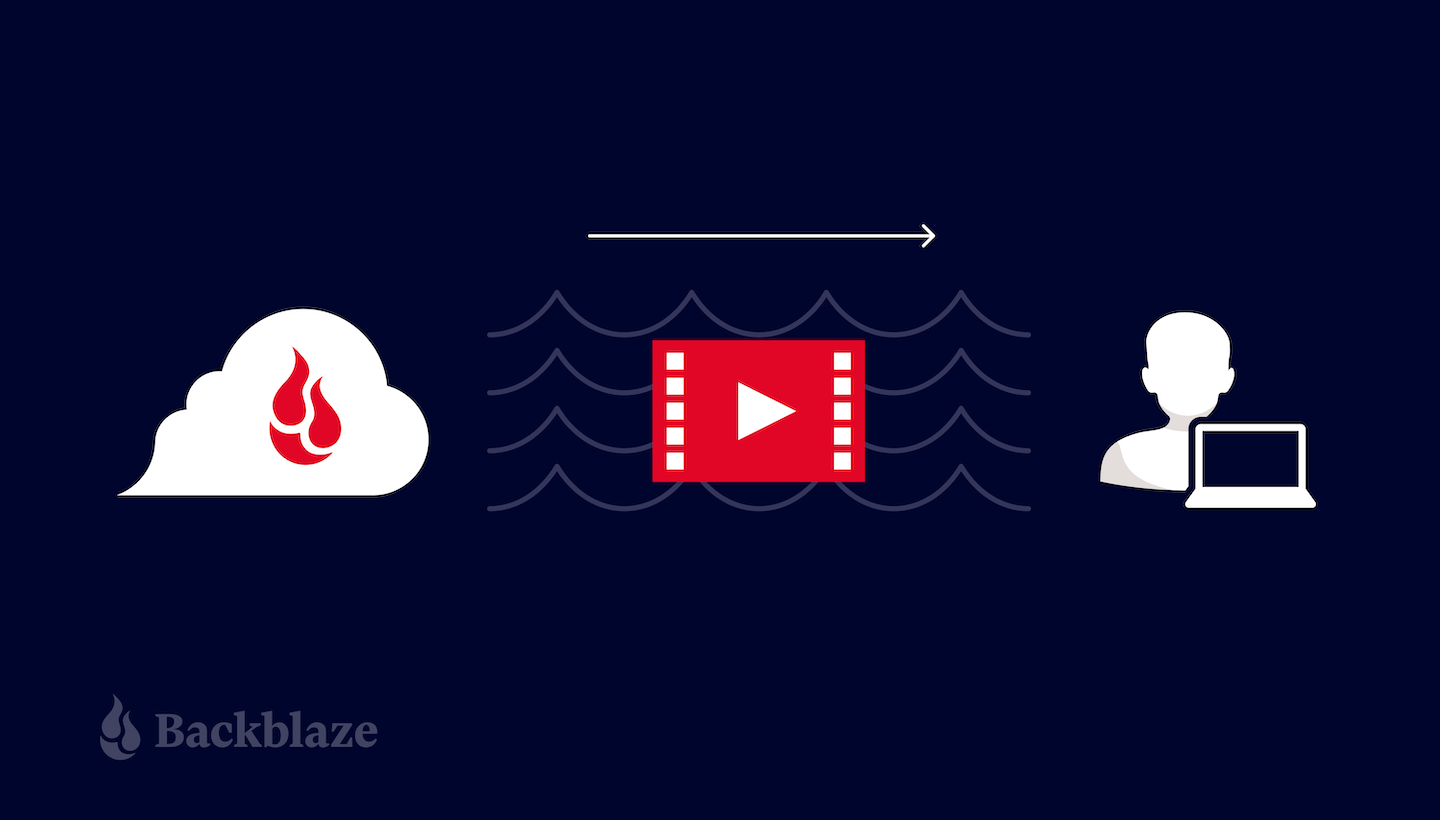
This post was originally published in 2017 and updated in 2019 and 2023 to share the latest information on cloud storage tiering.
Temperature, specifically a range from cold to hot, is a common way to describe different levels of data storage. It’s possible these terms originated based on where data was historically stored. Hot data was stored close to the heat of the spinning drives and CPUs. Cold data was stored on drives or tape away from the warmer data center, likely tucked away on a shelf somewhere.
Today, they’re used to describe how easily you can access your data. Hot storage is for data you need fast or access frequently. Cold storage is typically used for data you rarely need. The terms are used by most data storage providers to describe their tiered storage plans. However, there are no industry standard definitions for what hot and cold mean, which makes comparing services across different storage providers challenging.
It’s a common misconception that hot storage means expensive storage and that cold storage means slower, less expensive storage. Today, we’ll explain why these terms may no longer be serving you when it comes to anticipating storage cost and performance.
Defining Hot Storage
Hot storage serves as the go-to destination for frequently accessed and mission-critical data that demands swift retrieval. Think of it as the fast lane of data storage, tailored for scenarios where time is of the essence. Industries relying on real-time data processing and rapid response times, such as video editing, web content, and application development, find hot storage to be indispensable.
To achieve the necessary rapid data access, hot storage is often housed in hybrid or tiered storage environments. The hotter the service, the more it embraces cutting-edge technologies, including the latest drives, fastest transport protocols, and geographical proximity to clients or multiple regions. However, the resource-intensive nature of hot storage warrants a premium, and leading cloud data storage providers like Microsoft’s Azure Hot Blobs and AWS S3 reflect this reality.
Data stored in the hottest tier might use solid-state drives (SSDs), which are optimized for lower latency and higher transactional rates compared to traditional hard drives. In other cases, hard disk drives are more suitable for environments where the drives are heavily accessed due to their higher durability standing up to intensive read/write cycles.
Regardless of the storage medium, hot data workloads necessitate fast and consistent response times, making them ideal for tasks like capturing telemetry data, messaging, and data transformation.
Defining Cold Storage
On the opposite end of the data storage spectrum lies cold storage, catering to information accessed infrequently and without the urgency of hot data. Cold storage houses data that might remain dormant for extended periods, months, years, decades, or maybe forever. Practical examples might include old projects or records mandated for financial, legal, HR, or other business record-keeping requirements.
Cold cloud storage systems prioritize durability and cost-effectiveness over real-time data manipulation capabilities. Services like Amazon Glacier and Google Coldline take this approach, offering slower retrieval and response times than their hot storage counterparts. Lower performing and less expensive storage environments, both on-premises and in the cloud, commonly host cold data.
Linear Tape Open (LTO or Tape) has historically been a popular storage medium for cold data, though manual retrieval from storage racks renders it relatively slow. To access data from LTO, the tapes must be physically retrieved from storage racks and mounted in a tape reading machine, making it one of the slowest, therefore coldest, methods of storing data.
While cold cloud storage systems generally boast lower overall costs than warm or hot storage, they may incur higher per-operation expenses. Accessing data from cold storage demands patience and thoughtful planning, as the response times are intentionally sluggish.
With the landscape of data storage continually evolving, the definition of cold storage has also expanded. In modern contexts, cold storage might describe completely offline data storage, wherein information resides outside the cloud and remains disconnected from any network. This isolation, also described as air gapped, is crucial for safeguarding sensitive data. However, today, data can be virtually air-gapped using technology like Object Lock.
Traditional Views of Cold and Hot Data Storage
| Cold | Hot | |
|---|---|---|
| Access Speed | Slow | Fast |
| Access Frequency | Seldom or Never | Frequent |
| Data Volume | Low | High |
| Storage Media | Slower drives, LTO, offline | Faster drives, durable drives, SSDs |
| Cost | Lower | Higher |
What Is Hot Cloud Storage?
Today there are new players in data storage, who, through innovation and efficiency, are able to offer cloud storage at the cost of cold storage, but with the performance and availability of hot storage.
The concept of organizing data by temperature has long been employed by diversified cloud providers like Amazon, Microsoft, and Google to describe their tiered storage services and set pricing accordingly. But, today, in a cloud landscape defined by the open, multi-cloud internet, customers have come to realize the value and benefits they can get from moving away from those diversified providers.
A wave of independent cloud providers are disrupting the traditional notions of cloud storage temperatures, offering cloud storage that’s as cost-effective as cold storage, yet delivering the speed and availability associated with hot storage. If you’re familiar with Backblaze B2 Cloud Storage, you know where we’re going with this.
Backblaze B2 falls into this category. We can compete on price with LTO and other traditionally cold storage services, but can be used for applications that are usually reserved for hot storage, such as media management, workflow collaboration, websites, and data retrieval.
The newfound efficiency of this model has prompted customers to rethink their storage strategies, opting to migrate entirely from cumbersome cold storage and archival systems.
What Temperature Is Your Cloud Storage?
When it comes to choosing the right storage temperature for your cloud data, organizations must carefully consider their unique needs. Ensuring that storage costs align with actual requirements is key to maintaining a healthy bottom line. The ongoing evolution of cloud storage services, driven by efficiency, technology, and innovation, further amplifies the need for tailored storage solutions.
Still have questions that aren’t answered here? Join the discussion in the comments.
Hot vs. Cold Cloud Storage FAQs
Hot cloud storage refers to a type of cloud storage that is designed for data that needs to be accessed frequently and quickly. It delivers low latency and fast retrieval. Hot cloud storage is optimized to be highly performant and often offers features like high availability, durability, and scalability. It is commonly used for application storage, content delivery, streaming media, active archive, real-time analytics, and any frequently accessed workloads.
Cold cloud storage refers to a type of cloud storage that is designed for infrequently accessed or long-term retention of data. It is commonly used for storing archives, historical data, and regulatory compliance requirements where immediate access is not a priority. Cold cloud storage typically provides lower storage costs compared to hot storage, but retrieval times may be hours or up to days longer and you may be charged extra for expedited retrieval.
Cold storage and hot storage are two distinct categories of data storage based on their access frequency and cost. Cold storage is typically used to store infrequently accessed or archival data at a lower cost but with potentially longer retrieval times and fees for expedited retrieval. Hot storage, on the other hand, is designed with low latency and fast retrieval in mind, offering higher performance. The choice between cold and hot storage depends on the specific requirements and access patterns of the data being stored.
Hot cloud storage should be used when you require immediate access to frequently accessed data, low latency, and fast retrieval. It is suitable for applications that demand real-time analytics, content delivery, or frequently accessed database workloads. Consider the access patterns, retrieval time requirements, and cost considerations to determine whether hot or cold storage is the right choice for your specific use case.
Hot cloud storage provides immediate access to data with low latency, making it well-suited for real-time applications and high-performance workloads, but also any data that needs to be accessed fast. Additionally, hot storage often offers high availability and durability, ensuring data is readily accessible and protected from failures. It is also scalable, allowing you to easily accommodate growing storage needs.
Cold cloud storage typically provides a cost-effective solution for storing infrequently accessed or archival data, however you can expect longer wait times to retrieve your data and sometimes high fees for doing so. It works well for data that has long-term retention and compliance requirements. When storing data in cold cloud storage, it’s important to make sure you don’t need to access it quickly. It may seem like it would be good for data backups and archives, however when you need access to that kind of data, you typically don’t want to wait. Take that into consideration when deciding what kind of cloud storage would be best for your use case.




